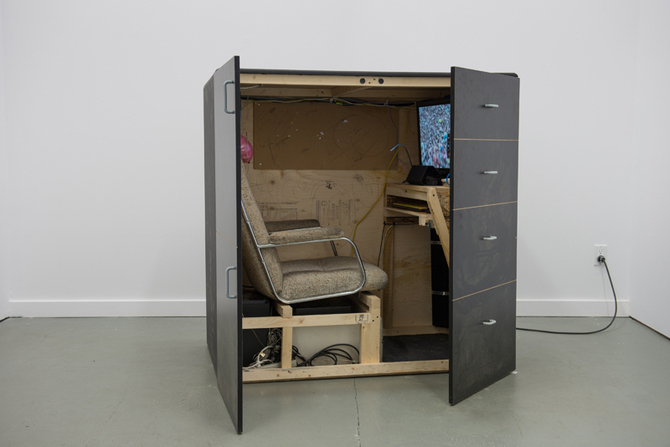Search
To search for an exact match, type the word or phrase you want in quotation marks.
A*DESK has been offering since 2002 contents about criticism and contemporary art. A*DESK has become consolidated thanks to all those who have believed in the project, all those who have followed us, debating, participating and collaborating. Many people have collaborated with A*DESK, and continue to do so. Their efforts, knowledge and belief in the project are what make it grow internationally. At A*DESK we have also generated work for over one hundred professionals in culture, from small collaborations with reviews and classes, to more prolonged and intense collaborations.
At A*DESK we believe in the need for free and universal access to culture and knowledge. We want to carry on being independent, remaining open to more ideas and opinions. If you believe in A*DESK, we need your backing to be able to continue. You can now participate in the project by supporting it. You can choose how much you want to contribute to the project.
You can decide how much you want to bring to the project.

A darkroom, amongst many other things, is a more or less public place for having sexual encounters. The lack of light provides the tranquillity granted by anonymity and, what is more, makes sight not be the most important sense. All darkrooms have particular codes and their own social agreement, and it is these very conditions that gives them the autonomy to redefine what is appropriate and correct regarding the use of the body.
A well-known darkroom is the one to be found at the Berghain (the equally well renowned club that saw the rise of techno in Berlin around the 90s). Berghain began with Snax, an itinerant fetish night, just for men, that finally, in 1998, found its permanent location in Ostgut. The venue was sold in 2003 but in 2004 was reborn as Berghain/Panorama. Just as in its origins, Berghain and sex continue to be inseparable. It is present in the programme, in Lab.Oratory [[Sex club located in the basement of Berghain]] , and in the aforementioned darkrooms. Thanks also to the sex; in the club a spirit of a liberation of the body stays alive, one that is tied to techno and the culture of the club itself. A spirit born from hedonism that connects with the most ancestral definition of the fiesta, bringing with it an indulgence of the senses through dance. The shared, undoubtedly erotic, energy creates community as it vibrates through the bodies, connecting them in ecstasy and enjoyment. To a large extent, this abandonment to the Dionysian is possible thanks to the politics Berghain maintains regarding images: there are no mirrors and cameras are prohibited, so it’s not possible to take photographs nor record film or audio. With this set of rules, Berghain vindicates a stop looking in order to vibrate, forget sight and re-encounter the body. We could say, therefore, that by eliminating the gaze, the whole of Berghain functions like a darkroom.
Facebook, one of the epicentres of the image, makes use of the 1.790 million users that feed their database each minute. Internet has become the administrator of this data (these images and with them, desire) with which to create the information that subsequently creates consumer fluxes. Berghain, meanwhile as a darkroom, functions as a place of resistance against these new logics of the capitalising of desire. On entering Berghain, this flux of economic production doesn’t pass through security controls. With the simple gesture of relinquishing a mobile phone, we abandon the eye, to recuperate the body. Wit this we abandon the abstract rhythm of financial algorithms that have infiltrated our understanding of time, to enter into party time: that of celebration and hedonism, the body and sex. Inside, time is experienced there as a different unity from the fractions of production into which we divide the day, opposing categorically the time of work and its equivalence in value and productivity. Nevertheless, Berghain for several years now lives a paradox. Images of the interior have been filtered out; the club has become one of the great attractions for a large part of Berlin’s tourism, and even though it complies with this function as a place of resistance in the construction of affection, it has indirectly become an agent of gentrification and an economic asset for the city. It is not an isolated case, all places of resistance have seen themselves affected by the logics of production of cultural companies. It is precisely these companies that, through images, convert affection into potential productivity at the service of the markets. By substituting the body for the image, they achieve a virtual recreation of the feelings of community through the screen.

In the darkrooms of Jon Rafman there is only room for one person and only the one who enters can feel and gaze at the fixed point from where incessant images are emitted. They are rooms for pleasure but in them the image substitutes the body of the other, or of others. If we trace the origin of Rafman’s screen-rooms, we come to a place quite different from the Berghain. We come to sex shop cabins, where masturbation is done in solitude. Screens have expanded the voyeuristic gaze, crippling the use of any sense other than sight and impeding the presence of more than one subject. In the progressive abandoning of the body of the other, and of one’s own, darkrooms cede their place to a new model: screen rooms (or the symbolic space created around us when we place ourselves in front of the computer or a mobile phone, where only the eye is necessary for our pleasure). The collective, as we understand it, has already disappeared as pleasure and desire don’t need the presence of the other, now it is enough to connect our gaze to a specific flow of desire, emitted always from the screen. Desire at the service of an image that exists as a tool of market logics, logics that don’t conform with the erasure of bodies so much as aspire to substitute reality itself.
Virtual sex promises to be more real, when all is said and done, for decades now we’ve been training the eye in the use of images that allow us to experience it as such. Virtual reality glasses are the latest model of the screen-room, to the extent that it derives from the eye without body. With them reality is no longer necessary and all sexual and erotic energy exists simply as consumer data shared by IRL on the Internet. If fucking was once a pleasure with the possibility of being totally unproductive, this reality is now increasingly distant.
In opposition to this future of pleasure, the use of the body defended at Berghain is vital for the recuperation of the body. The party, the erotic, and sex all have the capability to establish relations of community, a collective cause. Understood in this way, sex is still able to unite us socially through an unproductive energy, that reacts to the erotic rhythm of all social relations. Understood like this, sex, body on body, is needed to abandon this understanding of desire and the social based on likes and shares, where all movement is found at the service, and function, of its very maintenance and regeneration. We vindicate the unproductive; long live the party, physical contact and its eroticism of the carnal rather than that of images. Let’s experience the body as a place of rebellion and survival, to fight and organise ourselves against the desperate endeavours to control the flow of culture, and with it, subjects.


Virginia Lázaro Villa, lives in London, she is an artist and art critic and what she’s most interested in is iconoclasm and the destruction of things in general. She’s co-directed since 2015 the contemporary art magazine and platform Nosotros and for a while now has worked writing for different media and magazines, as well as doing a few other odd jobs that bring in the real money.
"A desk is a dangerous place from which to watch the world" (John Le Carré)